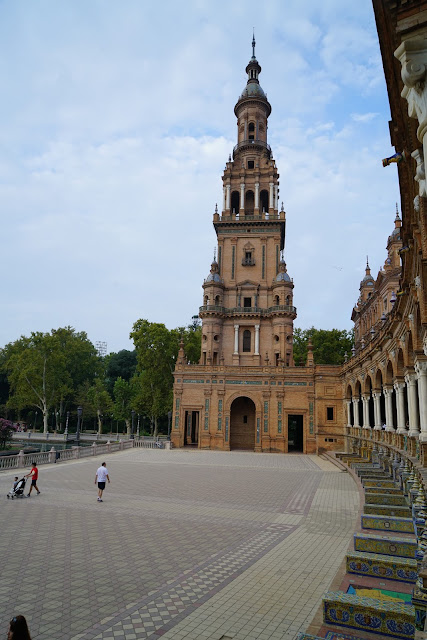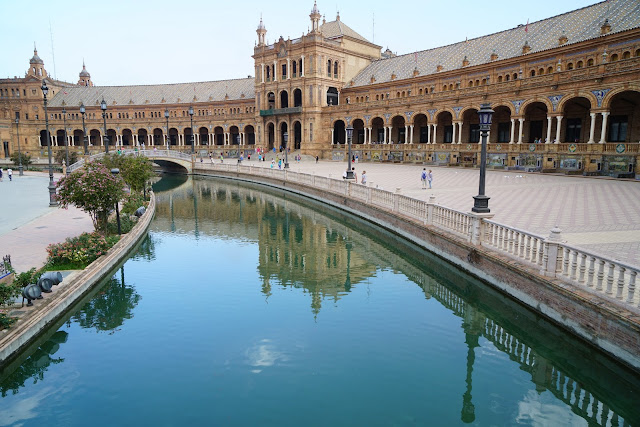Spain is a very special country. Its people are very conservative. But those who are not, are very radical in what they think and what they do. There is only one Deláquez. There is only one Cervantes. There is only Lorca. There is only one Picasso. There is only one Dali. There is only one Miró. There is only one Gaudy. Whatever the truth maybe. They all got to eat.

The Spanish love fruit. They know how to make them taste good, whether fresh or processed.

They know how to make lines look beautiful in their bridges

and in their hotels, mixing difference with formal identity.

Some very classical lines mixed with lines from the Middle East.

The exterior of our hotel with black cast iron grille and wall lamp, white walls enclosed by bands of blue glazed tiles and green plants

Right opposite to it, is one of its most successful department stores.

This is part of the campus of the University of Seville, a short distance from our hotel

Right in the middle of the city are the remains of a Roman aqueduct.

Although the Mayans and the North American Indians have been smoking tobacco since the dawn of history, it was the Spanish who invented the cigar. And cigars and cigarettes are still sold in specialist boutiques in Spain. Since 2010, to comply with WHO directives, all smoking are now prohibited in indoor public places, workplaces and in transport vehicles.

A fountain in a round-about with round stupa-like pillars in the middle probably learned from the Indians .

My first glimpse of our destination for the morning, the University of Seville (Universidad de Sevilla), which stood on the site of the Real Fábrica de Tabacos (Royal Tobacco Factory) the building of which begun by Charles III. It's the second largest building in the whole of Spain, just behind the royal residence El Escorial. Since the 1950s it has been used as the Rectorate of the University of Seville, together with the Schools of Law, Philology, Geography and History. It started life in 1505 as the Colegio Santa María de Jesús under Archdeacon Maese Rodrigo Fernandez de Santaella, for the purposes of preparing Dominican missionaries for work amongst he Moors and the Jews shortly after the Spanish kings had recovered control of the country from the Moors and was confirmed as a practicing university the same year by the papal bull of Pope Julius II to grant degrees in logic, philosophy, theology, canon and civil law.. It is now one of the top-ranked universities in the country with more than 60,000 students.
On our way there, we passed by the Torre del Oro (Tower of Gold) by the banks of the Quadalquivir River. Seville is the largest river port in Spain, just 50 miles from the Atlantic. It was from here that Magellan set sail for the East Indies between 1519-1522. It's a 12-sided military watchtower built in 1220-1221 by the Almohad Caliphate to bar access to the Arenal District of Seville by with a fleet of boats chained together up to the Triana, on the opposite side of the river. In the Middle Ages, it served as a prison. It was damaged during the Lisbon Earthquake of 1755 but was repaired in 1760.The tower is divided into three levels, with the circular uppermost part added in 1769. It was again damaged by the revolutionaries in 1868 but was restored in 1900 and work to turn it into a Maritime Museum began in 1936 and was completed in 1944. On August 13, 1992, the Torre del Oro was made a brother to the Tower of Belem of Lisbon to celebrate the Universal Exposition in Seville.

One of the old canons there, retained for purely historical interest

A very 19th century building: probably a train station

Like many other European cities, to help cut down the volume of surface motor traffic, there are many depositories for bicycles

A government supported shop for agricultural wage-workers and laborers.

A shoe shop--Spain is famous for its leather shoes

Houses for the ordinary folks

A Mercedes-Benz showroom

A typical Iberian style building of the early 19th century.

We also passed by the famous Plaza de toros de la Real Maestranza de Caballería de Sevilla ( Bullfighting Ring for Royal Armory of Cavalry of Sevilla) with a capacity for 12,000. The bullfighting season starts every year with the Feria de Avril (The April Festival) and lasts until September. The bullfighting there is considered one of the toughest test of torreadors in the world. .

Another part of the bullring

Tourists flooding into the entrance to the rectory of the University of Sevilla to see its famous Plaza de España

We entered through the Puerta de Aragon ( the Aragon Gate), Aragon being one of the two royal houses which joined the house of Castilla to form the Spanish monarchy. The University's motto is "Equality, Liberty, Justice and Pluralism"

A tiled portrait decorating the wall

It was a huge place built in the form of a beautifully curved crescent

The stairs leading up

The lower portions of the walls and the underside of the steps are decorated with Moorish style glazed tiles

A south American Indian playing the pan pipe --from Colombia or Peru?

In front of the crescent shaped corridor are plaques on the wall and a map on the ground to represent each of the autonomous regions of Spain. There are a total of 17 autonomous communities plus two autonomous cities.

Part of the building now houses an office of Foreigners of the Ministry of Immigration

whilst another house an office of Employment and Social Security

A full view of the crescent

A closer view

I like the river like pond in front of the building

The floor of the plaza is paved with pebbles in mosaics of spirals and rectangles

A frontal view of the rectory

A closer view

The other side of the pond

reflections on the pond

More reflections

the paved floor in front of the building

Sevilla: In the centre is a portrait of Festive Sevilla in the Camino de Rocio. On the left is the Arco de Manara and on the right if the Torre de Fadrique

Jaen: In the centre is the famous Battle of Belen 1808. On the left is the Cathedral of Jaen and on the right is the the Arco Villalar and the Puerta de Jaen

Huesca: the central picture portrays the
foundation of the Monasterio de San Juan de la Pena (Monastery of St. John of Suffering) at the start of the
reign of the Aragon, with the "Cien de Turuel" (The Turuel Hundred)
defeating the Arabs, In the left is the Iglesia de San Miguel (St.
Michael Church); on the right is part of a Medieval wall


Guipuzcoa: The centrepiece portrays the "Oath of Status" when Alfonso VIII takes the Queen of Navarra as his wife.

Guadalajara: The centrepiece portrays the marriage of Felipe II with Isabel de Valois, daughter of Henrique II of France.

Granada: The centrepiece portrays the return of Granada by the Moorish governor to the Spanish king in 1492.

Cuenca: Alfonso VIII and the Duke of Castiglione.

Coruna: Carlos I leaving Coruna for Germany in 1518 where he would be crowned Holy Roman Emperor in 1519.

Cordoba: the recovery of Cordoba
Don Quixote and Sancho Panza
Castellon: Rejection of the authority of Pope Benedict XIII by Fernando of Aragon with Fray Vincente Ferror

Sevilla under the Romans


Cadiz: scenes of celebration

Cadiz: various scenes in Cadiz

Canarias: The settlement of Spanish rights over the Canarias with Portugal in 1495

Another unidentifiable portraits

Another one of such glazed portraits

Baleares: The swearing in for the rights and franchises over the Beleares Islands by James III

Avila: The return of Avila to Spain during the reign of Alfonso III in 864

Almeria: the Reconquest of Almeria in 1489

Alicante:The return of Alicante to Spain in 1246.

Alaya: The coronation of Alaya in 1332 during the reign of Alfonso XI

The countryside of Seville

Albacete: A scene depicting the revolt of the Comuneros in the 16th century against Moorish rule

Back to the main building

The corridors on the first floor

Time to leave for lunch



沒有留言:
張貼留言